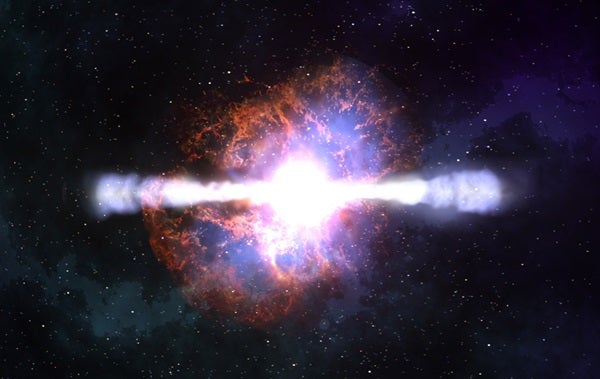GRBs are intense bursts of extremely high energy observed in distant galaxies. Bursts that last more than a couple seconds are known as long-duration gamma-ray bursts (LGRBs) and are associated with supernova explosions — powerful detonations at the ends of the lives of massive stars.
In just a matter of seconds, a typical burst releases as much energy as the Sun will in its entire 10-billion-year lifetime. The explosion itself is often followed by a slowly fading emission, known as an afterglow, which is thought to be created by collisions between the ejected material and the surrounding gas.
However, some gamma-ray bursts mysteriously seem to have no afterglow — they are referred to as dark bursts. One possible explanation is that clouds of dust absorb the afterglow radiation.
In recent years, scientists have been working to better understand how GRBs form by probing their host galaxies. Astronomers expected that the massive stars that were GRB progenitors would be found in active star-forming regions in these galaxies, which would be surrounded by a large amount of molecular gas — the fuel for star formation. However, there had been no observational results to back up this theory, leaving a long-standing mystery.
For the first time, a Japanese team of astronomers, led by Bunyo Hatsukade from the National Astronomical Observatory of Japan, has used ALMA to detect the radio emission from molecular gas in two dark LGRB hosts — GRB 020819B and GRB 051022 — at about 4.3 billion and 6.9 billion light-years, respectively. Although such radio emission had never been detected in the GRB host galaxies, ALMA made it possible with its unprecedentedly high sensitivity.
“We have been searching for molecular gas in GRB host galaxies for over 10 years using various telescopes around the world,” said Kotaro Kohno from the University of Tokyo. “As a result of our hard work, we finally achieved a remarkable breakthrough using the power of ALMA. We are very excited with what we have achieved.”
Another remarkable achievement made possible by the high resolution of ALMA was uncovering the distribution of molecular gas and dust in GRB host galaxies. Observations of GRB 020819B revealed a remarkably dust-rich environment in the outskirts of the host galaxy, whereas molecular gas was found only around its center. This is the first time that such a distribution among GRB host galaxies has been revealed.
“We didn’t expect that GRBs would occur in such a dusty environment with a low ratio of molecular gas to dust. This indicates that the GRB occurred in an environment quite different from a typical star-forming region,” said Hatsukade. This suggests that massive stars that die as GRBs change the environment in their star-forming region before they explode.
The research team believes that a possible explanation for the high proportion of dust compared to molecular gas at the GRB site is the difference in their reactions to ultraviolet radiation. Because the bonds between atoms that make up molecules are easily broken by ultraviolet radiation, molecular gas cannot survive in an environment exposed to the strong ultraviolet radiation produced by the hot massive stars in its star-forming region, including the one that would eventually explode as the observed GRB. Although a similar distribution is also seen in GRB 051022, this has yet to be confirmed due to the lack of resolution as the GRB 051022 host is located farther away than the GRB 020819B host. In any case, these ALMA observations support the hypothesis that it is dust that absorbs the afterglow radiation, causing the dark gamma- ray bursts.
“The results obtained this time were beyond our expectations. We need to carry out further observations with other GRB hosts to see if this could be general environmental conditions of a GRB site. We are looking forward to future research with the improved capability of ALMA,” said Hatsukade.










